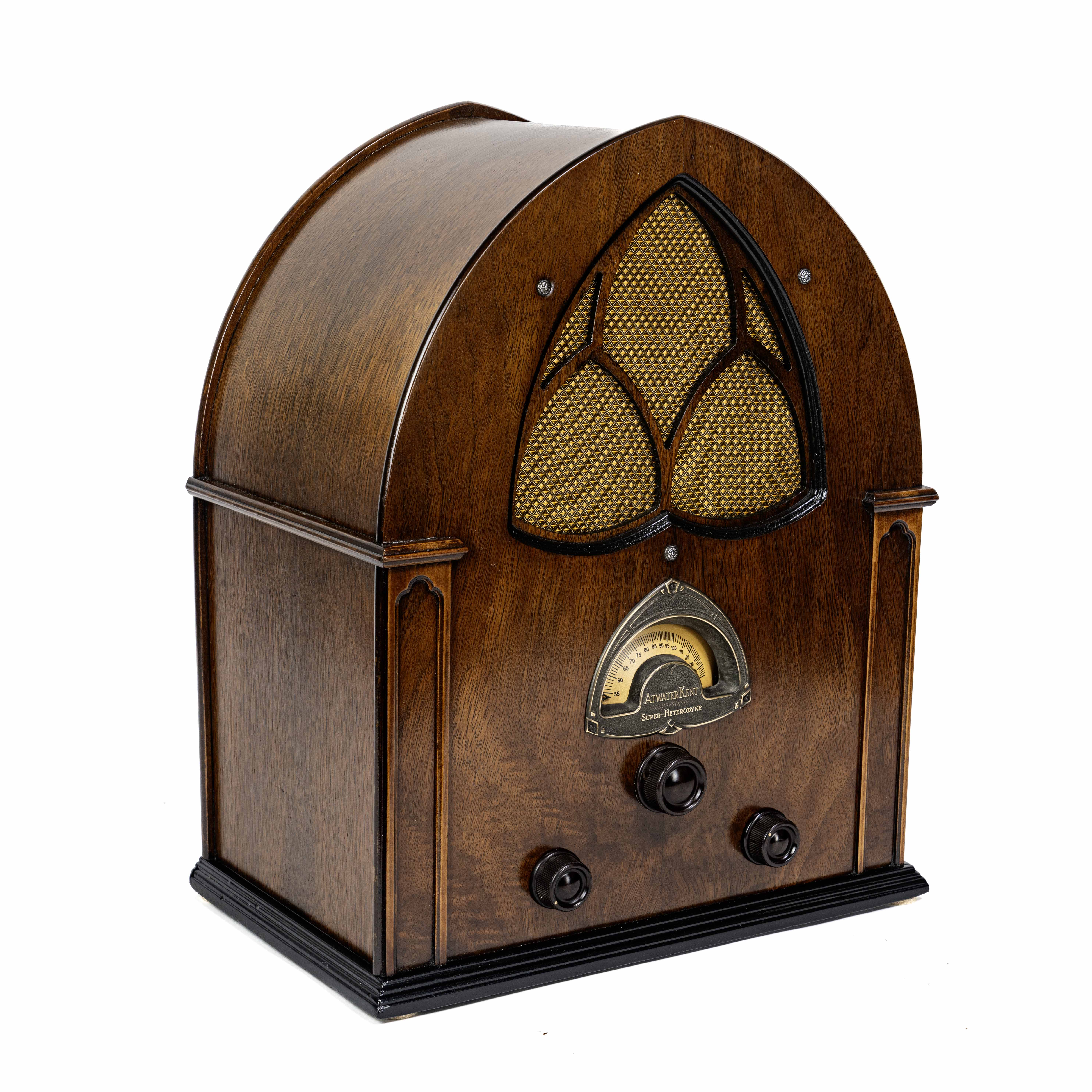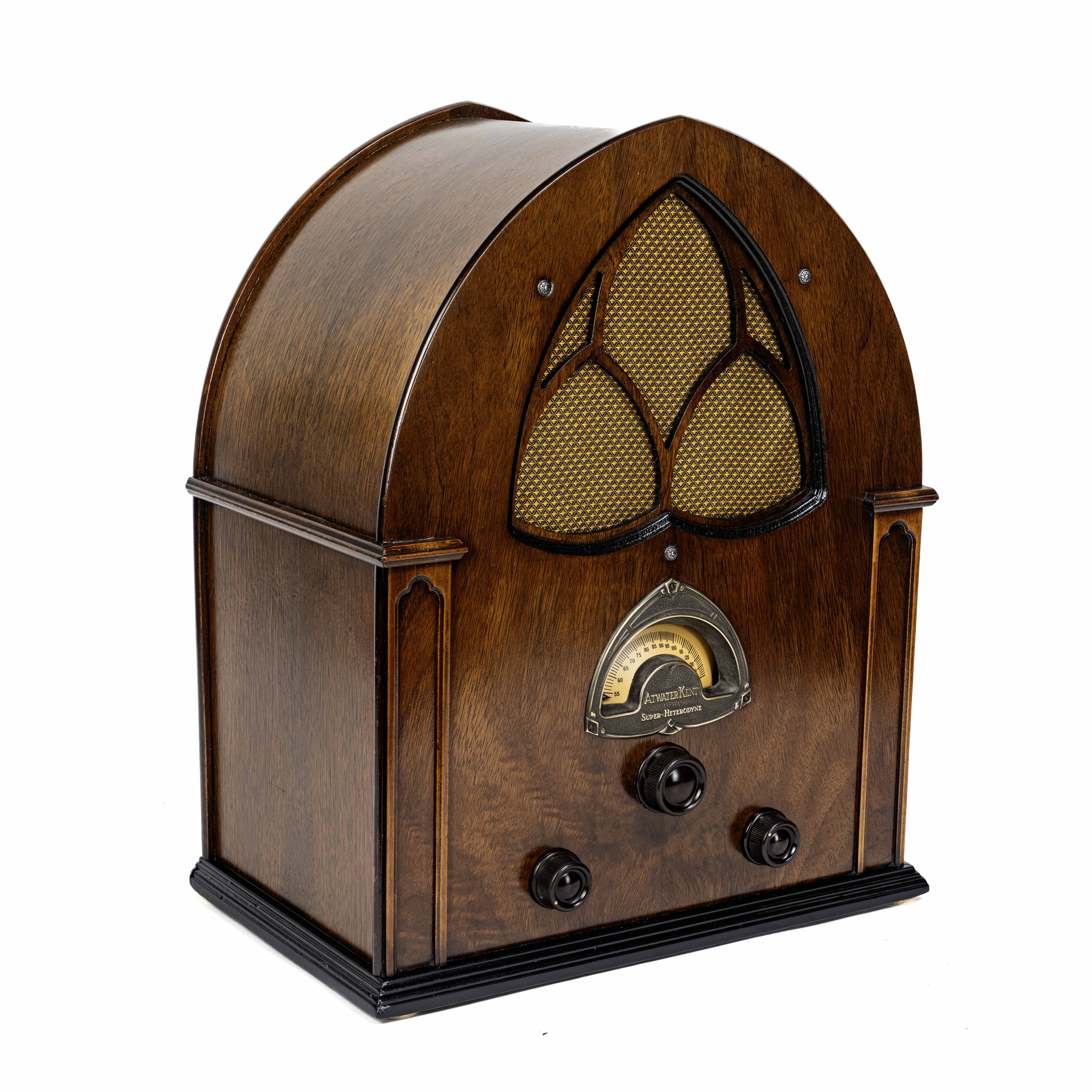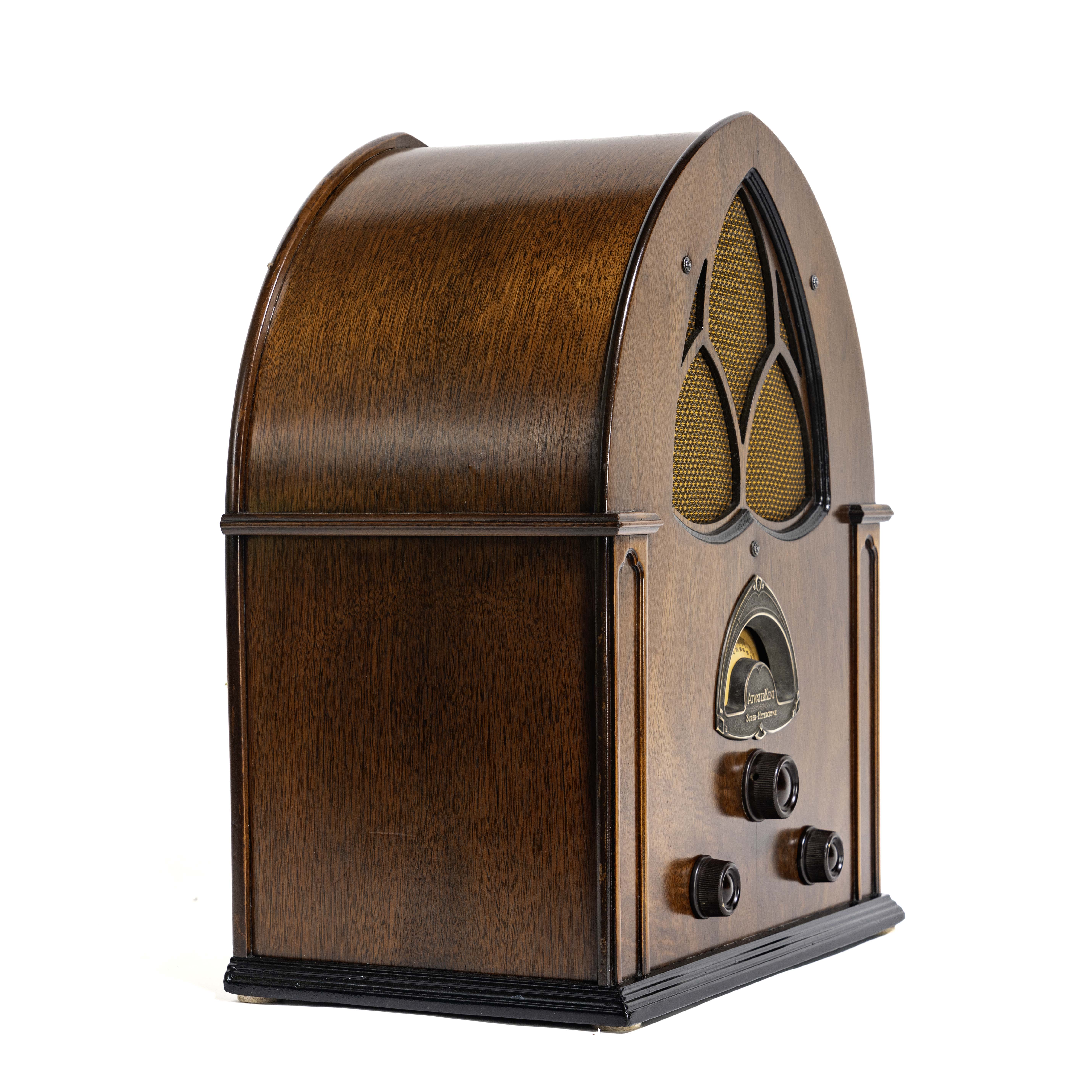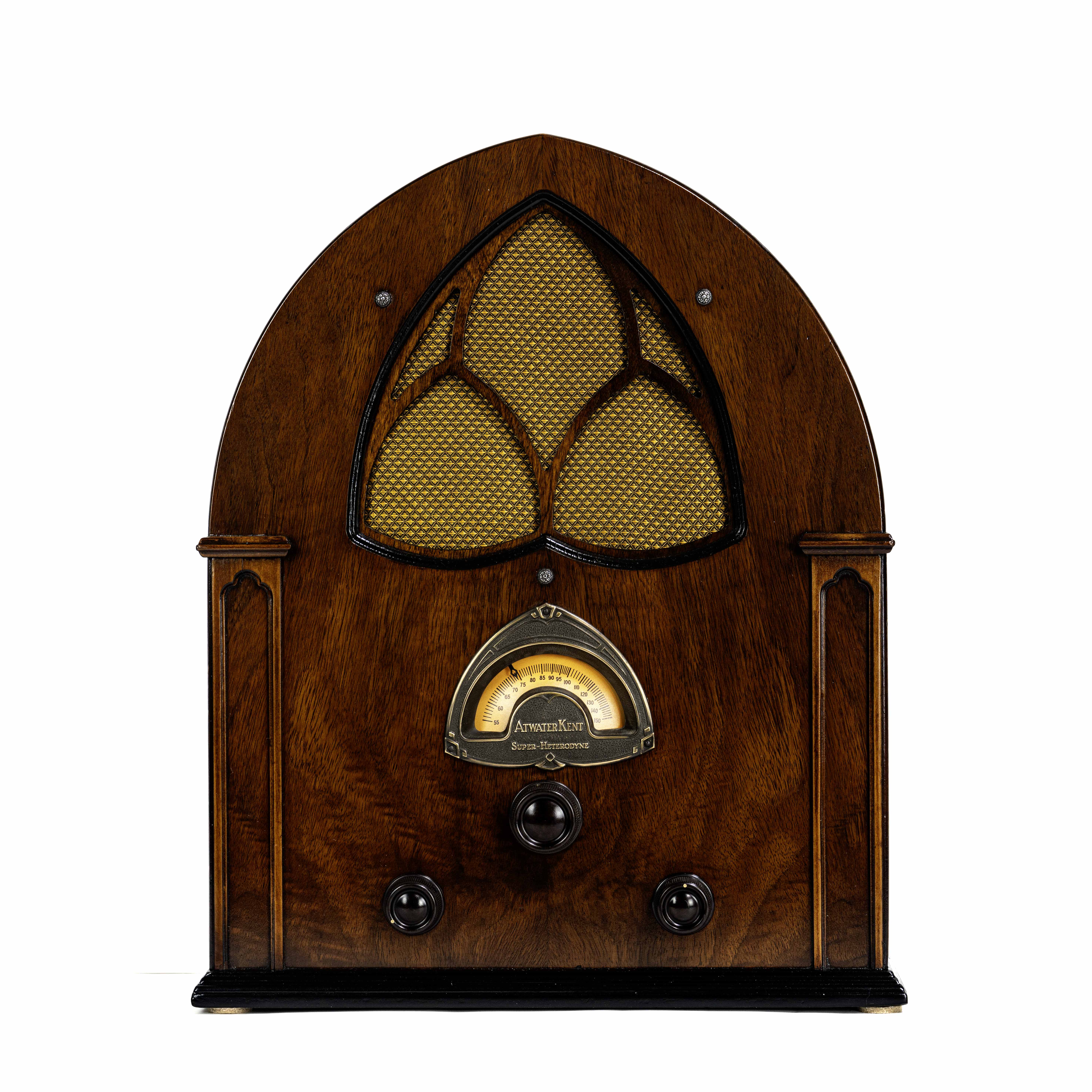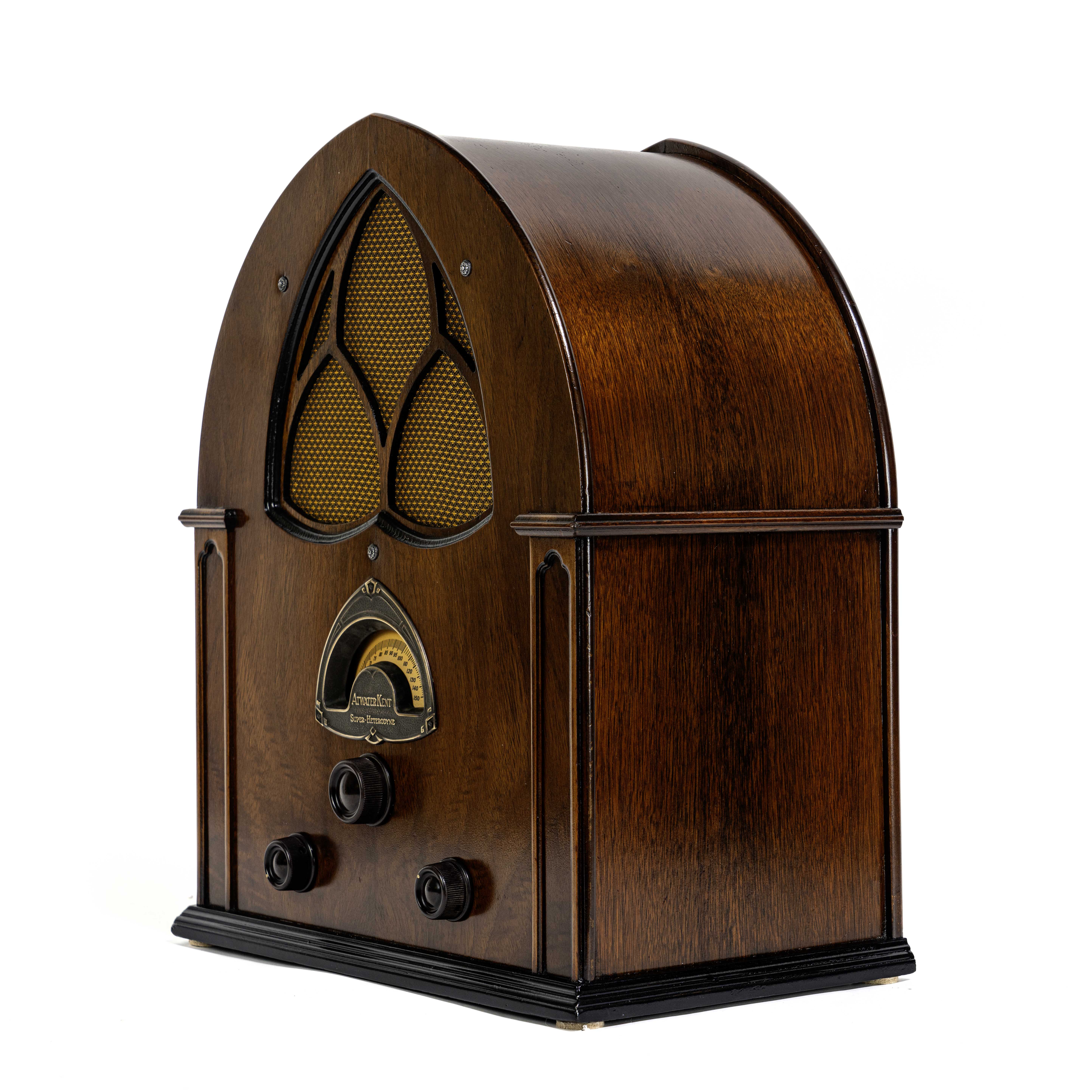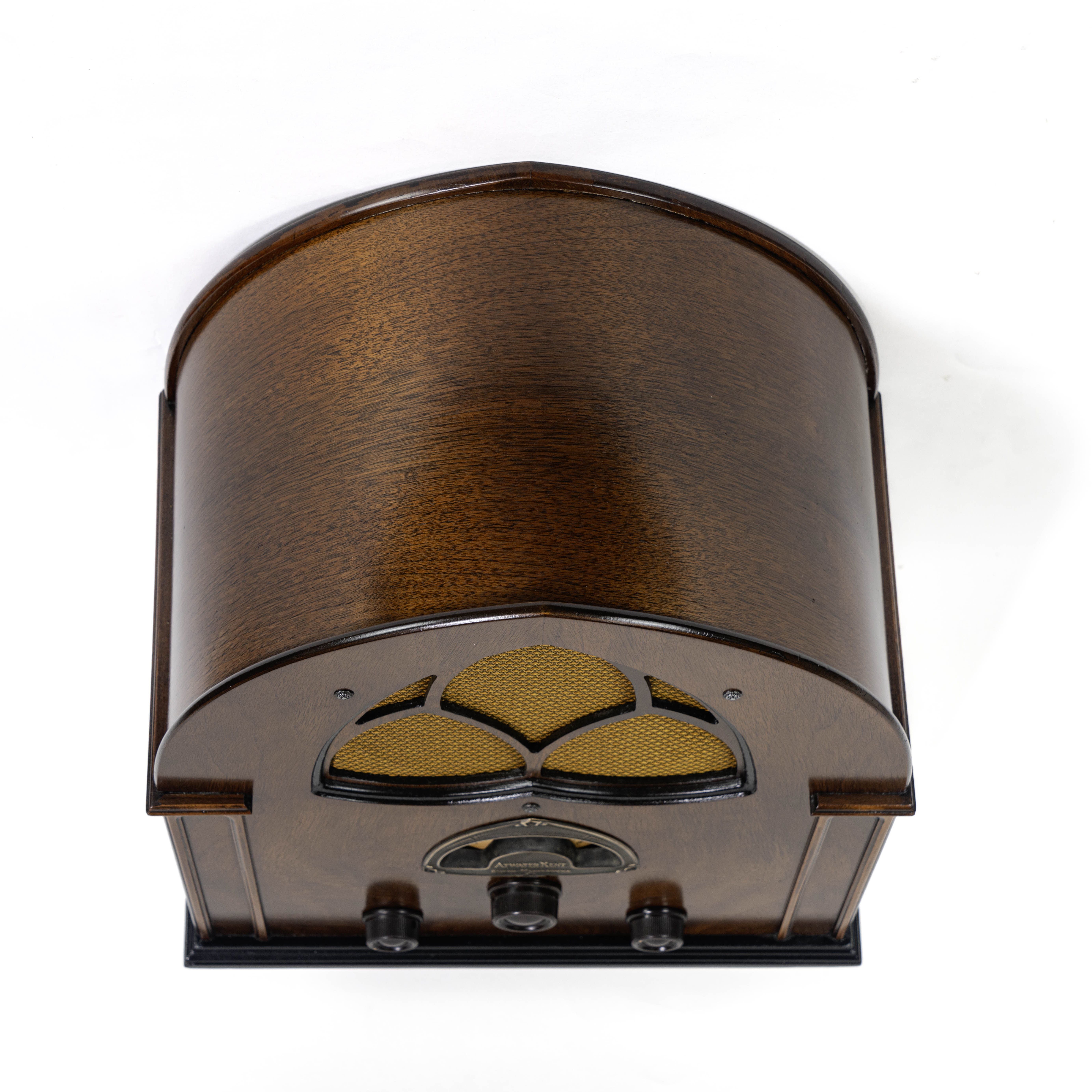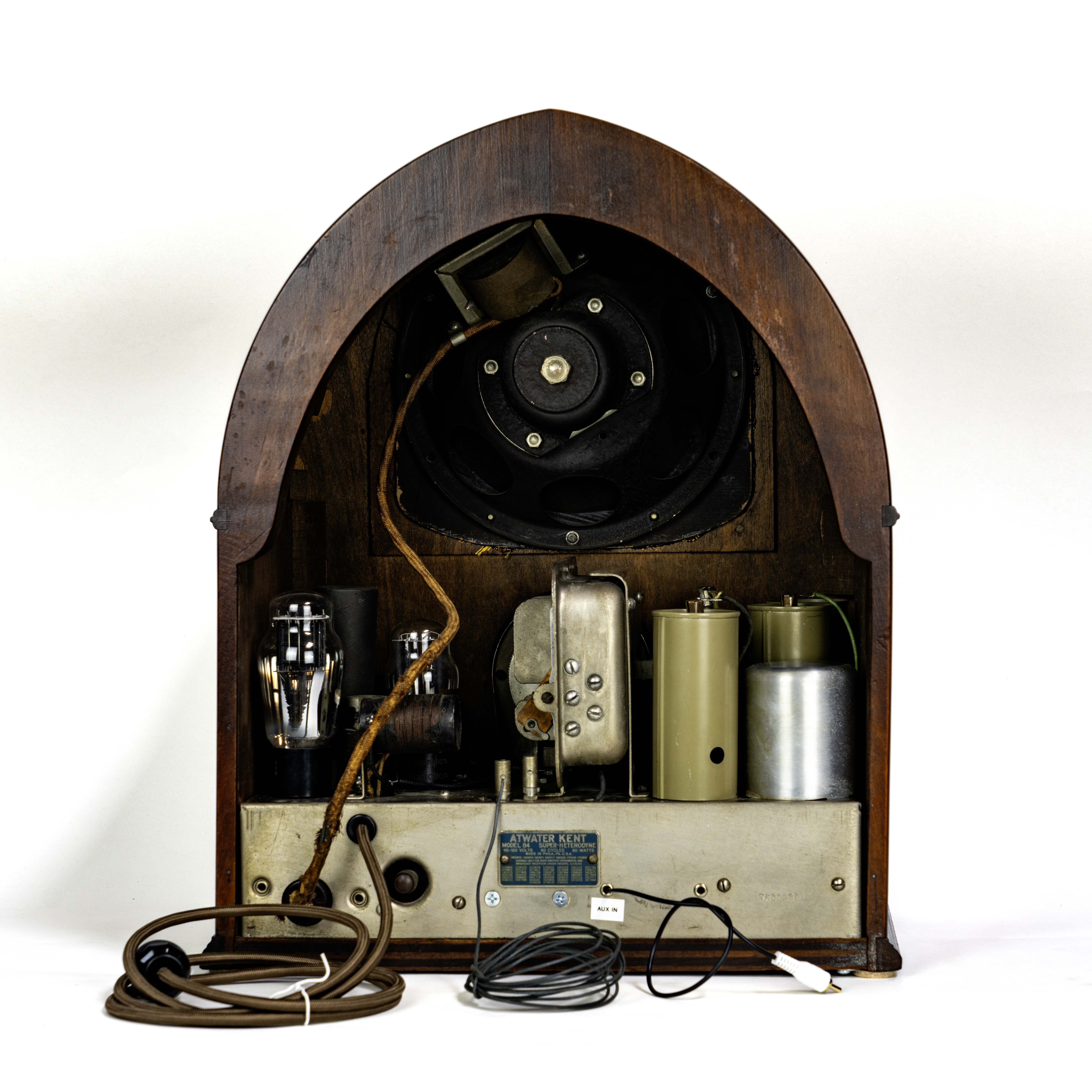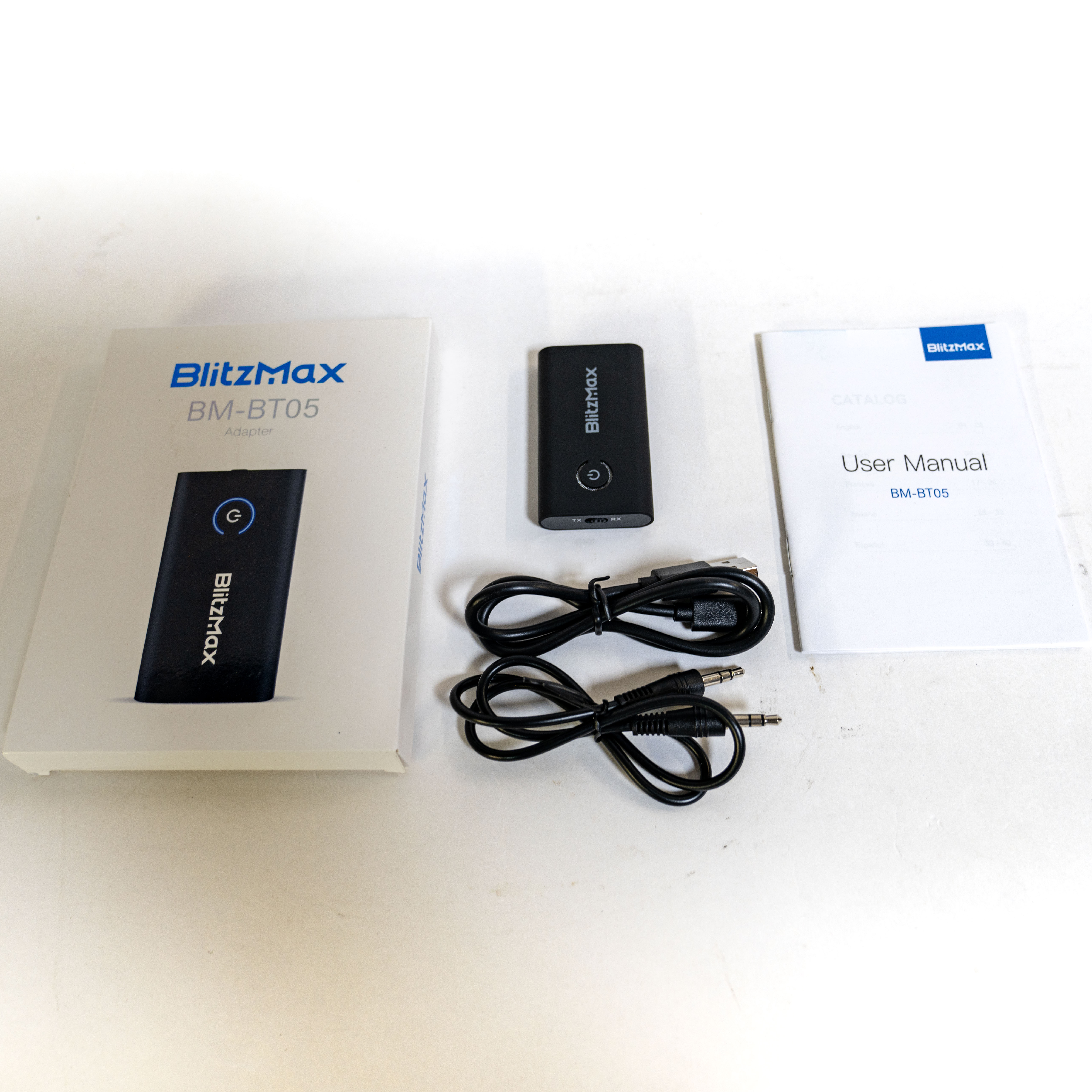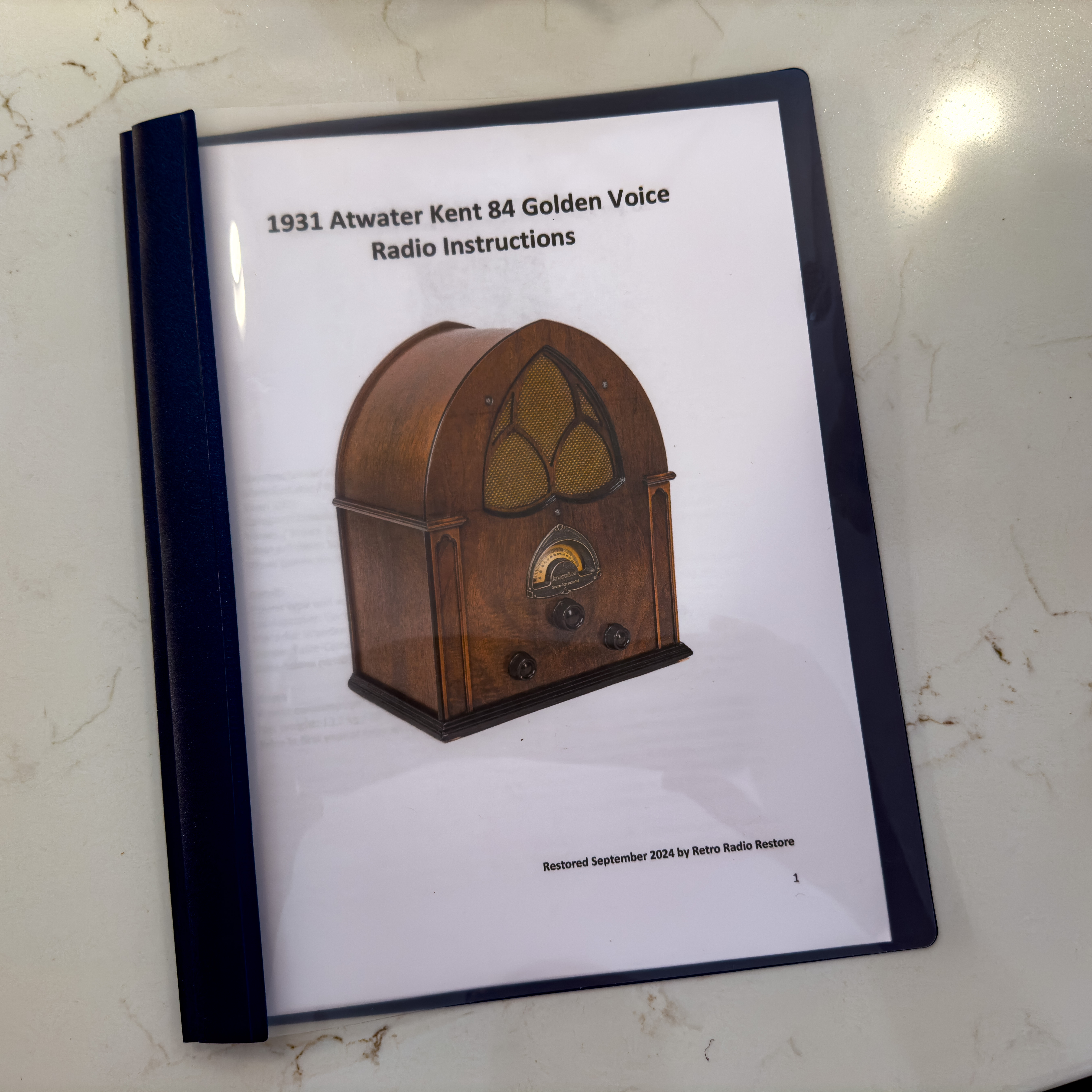- Radios
- >
- Atwater Kent 84 Cathedral (1931)
Atwater Kent 84 Cathedral (1931)
SKU:
$900.00
$900.00
Unavailable
per item
SOLD
This classic looking Atwater Kent ‘Golden Voice’ cathedral radio has been completely restored and finished in a clear semi-gloss lacquer. This six-tube, superheterodyne AM-band radio utilizes a variable IF stage circuit for greater performance and sensitivity. Its large 8-inch speaker produces deep rich sounds. Everything about this radio is of industrial strength (it weighs 30 pounds!) and has been rebuilt to last many, many years.
History – In 1902 Arthur Atwater Kent founded the Atwater Kent Manufacturing Works in Philadelphia, Pennsylvania which later became the Atwater Kent Manufacturing Company in 1919. In that year Atwater Kent already had 25 U.S. patents. He eventually held 93.
In 1921 he started to engage in radio, and the following year 1922 saw him advertising for radio parts and units, and end of 1922 Atwater Kent became the leading radio manufacturer in the USA. The production figures are impressive: from 1923 to 1927 over 1,317,760 sets have been produced. In 1936 Arthur Atwater Kent, fed up with cheap competition and unions, closed the factory. Being rich enough, he retired to Hollywood and enjoyed living among movie stars and high society. He died in 1949.
The model 84, marketed as the ‘Golden Voice’ was manufactured by Atwater Kent and introduced in early 1931, initially priced at $69.00. This cathedral style radio with its pointed arch, escutcheon and modest side pillars is highly coveted by collectors today. Atwater Kent described this and their similar radios as having the "Quick-Vision Dial" and exclusive Atwater Kent feature. All Stations are always in sight and evenly spaced, for instant, accurate tuning. An Important feature it was “...Easy to read as a clock, from any position..."
We purchased this ‘early version’ model 84 radio in 2021 from a collector who never restored it. The chassis was not working and needed a full restoration and upgrade.
Cabinet – We kept the original finish and performed a restoration. We cleaned the entire cabinet and toned the footer with black lacquer. We treated the veneers with a pre-conditioner and sanded the small cracks throughout to create a smooth finish. Some minor scratches could not be removed and remain as a legacy. The entire cabinet was sealed with a semi-gloss lacquer. This made the original veneers and book-matched walnut veneer pop. We added period correct grille cloth but kept the original control knobs. The result is this handsome looking radio that will last many, many years into the future.
Dial –The original dial was cracked, and we had it replaced with a modern reproduction. The dial mechanism itself was disassembled, cleaned, lubricated, aligned, and reassembled. We also replaced the ’rubber tire’ that provides friction between the dial control knob and the main variable capacitor tuning shaft. The brass escutcheon is original and was cleaned only enough to keep its patina well into the future.
Chassis – This was a complex restoration. Like many early 1930’s radios this one uses an IF amplifier with continuously variable sensitivity to control volume. We went through the entire underside of the chassis replacing every capacitor and resistor and replaced wires where needed. We cleaned and lubricated the tuning condenser and aligned the radio to its specifications. All tubes were checked and replaced where needed with NOS (new old stock) tubes. We also added a new vintage looking modern power cord.
We took extra steps and worked with the top expert at the California Historical Radio Society to ensure this radio produces no hum. It now plays very well across the dial and all bands a simple 12-foot antenna wire.
Speaker – Even though it performed well, we had the all-original 5-inch speaker cleaned and reinforced. The result is clear audio across the entire audio frequency range. This radio produces exceptional tones for its size and the great sound will fill the room. NOTE: like other radios of the early 1930’s volume is achieved by increasing the IF sensitivity. This means there is no AVC (automated volume control) like on modern radios so very powerful local stations can sound very loud. This is easily prevented by turning down the volume/sensitivity as the station is tuned in.
Bluetooth - Additionally, this radio has been fitted with an input to the audio stage for our exclusive Bluetooth / MP3 adapter which allows you to use the radio or your smartphone or music device. Access your streaming audio service or the playlist on your smart device to provide classic tunes and bring the warm, bright, analogue sound to any music or historical recording you choose. The quality of the sound is excellent, and you can control the volume on your device. You will have the best of “digital” and “analogue” combined.
Year of Manufacture: 1931
Band Frequency Range: 550 – 1500 KHz (AM Broadcast Band)
Dimensions (WHD): 15.5 x 19 x 9 inch.
Weight: 30 pounds
High definition video on YouTube here: youtu.be/mi7_Ja4nupQ
Follow the restoration history on our Instagram channel: www.instagram.com/retroradiorestore
History – In 1902 Arthur Atwater Kent founded the Atwater Kent Manufacturing Works in Philadelphia, Pennsylvania which later became the Atwater Kent Manufacturing Company in 1919. In that year Atwater Kent already had 25 U.S. patents. He eventually held 93.
In 1921 he started to engage in radio, and the following year 1922 saw him advertising for radio parts and units, and end of 1922 Atwater Kent became the leading radio manufacturer in the USA. The production figures are impressive: from 1923 to 1927 over 1,317,760 sets have been produced. In 1936 Arthur Atwater Kent, fed up with cheap competition and unions, closed the factory. Being rich enough, he retired to Hollywood and enjoyed living among movie stars and high society. He died in 1949.
The model 84, marketed as the ‘Golden Voice’ was manufactured by Atwater Kent and introduced in early 1931, initially priced at $69.00. This cathedral style radio with its pointed arch, escutcheon and modest side pillars is highly coveted by collectors today. Atwater Kent described this and their similar radios as having the "Quick-Vision Dial" and exclusive Atwater Kent feature. All Stations are always in sight and evenly spaced, for instant, accurate tuning. An Important feature it was “...Easy to read as a clock, from any position..."
We purchased this ‘early version’ model 84 radio in 2021 from a collector who never restored it. The chassis was not working and needed a full restoration and upgrade.
Cabinet – We kept the original finish and performed a restoration. We cleaned the entire cabinet and toned the footer with black lacquer. We treated the veneers with a pre-conditioner and sanded the small cracks throughout to create a smooth finish. Some minor scratches could not be removed and remain as a legacy. The entire cabinet was sealed with a semi-gloss lacquer. This made the original veneers and book-matched walnut veneer pop. We added period correct grille cloth but kept the original control knobs. The result is this handsome looking radio that will last many, many years into the future.
Dial –The original dial was cracked, and we had it replaced with a modern reproduction. The dial mechanism itself was disassembled, cleaned, lubricated, aligned, and reassembled. We also replaced the ’rubber tire’ that provides friction between the dial control knob and the main variable capacitor tuning shaft. The brass escutcheon is original and was cleaned only enough to keep its patina well into the future.
Chassis – This was a complex restoration. Like many early 1930’s radios this one uses an IF amplifier with continuously variable sensitivity to control volume. We went through the entire underside of the chassis replacing every capacitor and resistor and replaced wires where needed. We cleaned and lubricated the tuning condenser and aligned the radio to its specifications. All tubes were checked and replaced where needed with NOS (new old stock) tubes. We also added a new vintage looking modern power cord.
We took extra steps and worked with the top expert at the California Historical Radio Society to ensure this radio produces no hum. It now plays very well across the dial and all bands a simple 12-foot antenna wire.
Speaker – Even though it performed well, we had the all-original 5-inch speaker cleaned and reinforced. The result is clear audio across the entire audio frequency range. This radio produces exceptional tones for its size and the great sound will fill the room. NOTE: like other radios of the early 1930’s volume is achieved by increasing the IF sensitivity. This means there is no AVC (automated volume control) like on modern radios so very powerful local stations can sound very loud. This is easily prevented by turning down the volume/sensitivity as the station is tuned in.
Bluetooth - Additionally, this radio has been fitted with an input to the audio stage for our exclusive Bluetooth / MP3 adapter which allows you to use the radio or your smartphone or music device. Access your streaming audio service or the playlist on your smart device to provide classic tunes and bring the warm, bright, analogue sound to any music or historical recording you choose. The quality of the sound is excellent, and you can control the volume on your device. You will have the best of “digital” and “analogue” combined.
Year of Manufacture: 1931
Band Frequency Range: 550 – 1500 KHz (AM Broadcast Band)
Dimensions (WHD): 15.5 x 19 x 9 inch.
Weight: 30 pounds
High definition video on YouTube here: youtu.be/mi7_Ja4nupQ
Follow the restoration history on our Instagram channel: www.instagram.com/retroradiorestore
